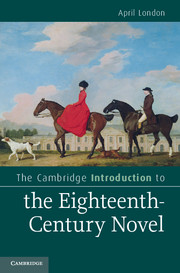Introduction
Published online by Cambridge University Press: 05 June 2012
Summary
The title pages of early to mid-eighteenth-century fictions rarely announce that what follows is a “novel.” Instead, they forecast tales, memoirs, travels, fortunes and misfortunes, histories, lives and opinions, sketches, journals, adventures, and expeditions. These tags point to the long gestation of what Samuel Richardson called this “new manner of writing” and its equally protracted struggle to escape its lowly rank in the hierarchy of genres. Only late in the period, in fact, do the novel’s contours as a distinct and creditable form become fully visible. Its deferred elevation owes something to the writing of literary critical histories that began with Clara Reeve’s 1785 Progress of Romance and to such collections as Anna Laetitia Barbauld’s 1810 The British Novelists in fifty volumes and Walter Scott’s 1821–4 Ballantyne’s Novelist’s Library in ten volumes. Even before such efforts to label and sort, however, the vagueness about names was more apparent than real, since actual readers throughout the period clearly grasped the family connection between the diverse titles. But the categorical slippages also, and importantly, reflect the status of the novel as a mode in process, its history one of continuous, if uneven, experimentation. This Introduction to the Eighteenth-Century Novel aims to convey a sense of that variety and experimentation by listening to the conversations novelists pursued through the medium of their fictions with their fellow writers, literary forebears, and surrounding culture.
Looking back, we can partially reconstruct the context for some of these experiments and speculate about the reasons for their eclipse or survival. Numbers flourished only briefly and left little trace (including the “it-narratives” written from the perspective of objects that follow Charles Johnstone’s Chrysal: Or, The Adventures of a Guinea in the 1750s and 1760s). Other subgenres seemed to drop from favor only to be adapted later to a more complex hybrid form (as with Samuel Richardson’s modifications of amatory and pious tales). Intrinsic merit in itself rarely accounts for the endurance of certain modes and the disappearance of others. In some instances, the reasons for these contrary courses postdate the original publication by several generations. Many early eighteenth-century writers, for instance, were casualties of early nineteenth-century efforts to enhance the respectability of novels by defining a masculine tradition stretching from Henry Fielding and Tobias Smollett through to Walter Scott.
- Type
- Chapter
- Information
- Publisher: Cambridge University PressPrint publication year: 2012



